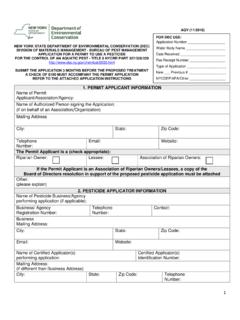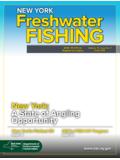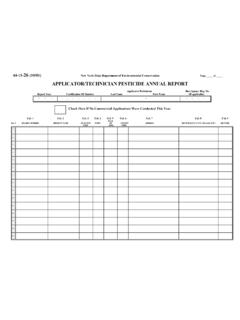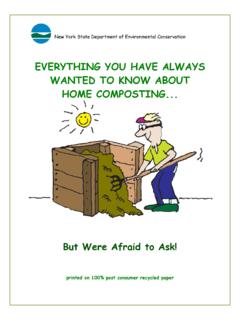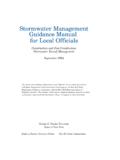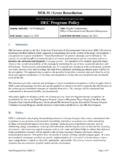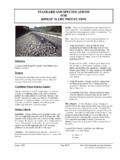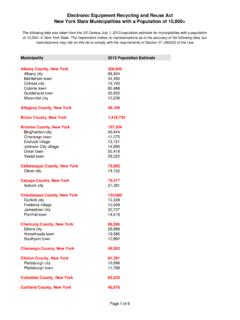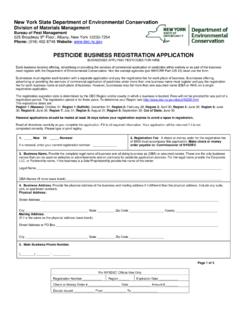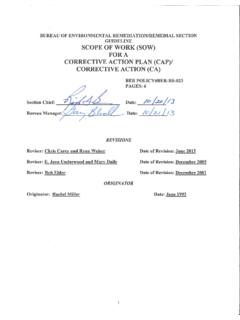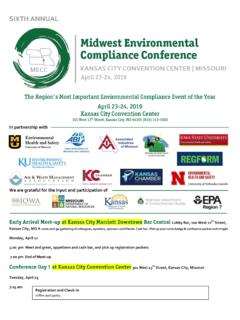Transcription of DER-10 Technical Guidance for Site Investigation and ...
1 ERRATA SHEET for DER-10 , Technical Guidance for Site Investigation and remediation Issued on May 3, 2010 Citation and Page Number Current Text Corrected Text Date Table , Document 9 (SMPs): Certified by column Certification column Page 21 Certified by = NYSPE Certification = (b) 2 Certified by = QEP or NYSPE Certification = (b) 1 since SMP is considered to be a work plan 09/14/2015 09/14/2015 Section (f)(2)(i) Page 131 for residential or restricted residential use, is to be two feet; for restricted residential use, is to be two feet; 11/07/2017 Final Program Policy, DER-10 Page 1 of 3 DER-10 / Technical Guidance for Site Investigation and RemediationNew York State Department of Environmental ConservationDEC Program PolicyIssuing Authority: Val Washington Title: Deputy Commissioner, Office of remediation and Materials Management Date Issued: May 3, 2010 Latest Date Revised: I.
2 Summary: This Guidance provides an overview of the site Investigation and remediation process for the New York State Department of Environmental Conservation (DEC) remedial programs administered by the Division of Environmental remediation (DER). These include the Inactive Hazardous Waste Disposal Site Remedial Program, known as the State Superfund Program (SSF); Brownfield Cleanup Program (BCP); Environmental Restoration Program (ERP); and Voluntary Cleanup Program (VCP); and certain petroleum releases. II. Policy: DER administers the SSF, BCP, ERP, VCP and Bulk Storage Programs and providesresponse to releases of petroleum.
3 This Guidance assists the user in developing and implementing Investigation and remediation projects involving contaminated sites under these programs administered by DER. It is a separate document of the requirements for a remedial program set forth in statute and regulation, as well as in Guidance . It reflects DER s experience and knowledge in developing and managing the various programs for the past 25 years. III. Purpose and Background: This Guidance provides the scope of activities needed to satisfyminimum requirements for the life-cycle of the site-specific remedial program under the SSF, BCP, ERP, and VCP, and for certain petroleum releases.
4 It facilitates consistent, accurate, efficient and timely completion of remedial projects. It also contains the minimum Technical activities DEC will generally accept for projects where DER oversight, approval or acceptance is sought or mandated by law. DER will, however, determine the acceptable minimum Technical activities for a particular site upon consideration of all the facts and circumstances of such site under the authority of applicable laws and regulations. No provision of this Guidance document should be construed to limit DER's authority to require additional Investigation and/or remediation based upon site-specific conditions.
5 Sections and present the scope and applicability of this Guidance document in more detail. No provisions of this Guidance , however, should be construed to alter the requirements of the Navigation Law or Environmental Conservation Law, or any regulation or order or permit having the force of law. This Guidance does not replace or supersede protocols established for emergency spill response actions, emergency drum removal actions, and other such events requiring immediate responses and follow-up. In such time-critical situations, existing Guidance established pursuant to applicable emergency response laws, regulations and policy, and directives of the on-scene DEC Spill Responder or Project Manager must be followed.
6 Final Program Policy, DER-10 Page 2 of 3 IV. Responsibility: Remedial Bureau C in DER is responsible for interpreting and maintaining this Guidance document. The procedures are to be used by DER staff and regulated entities responsible for sites in the remedial programs. V. Procedure: This Guidance assists the user in developing and implementing Investigation and remediation projects under the above described programs administered by DER. This Guidance is attached as a separate document and included herein by reference.
7 A summary of topics addressed by each chapter are provided below. Chapter 1 provides general information, establishes the basic rules-of-the-game for utilizing the Guidance , and includes issues which are common to many elements of a remedial program. Chapter 2 describes the minimum quality assurance guidelines and criteria for sampling and laboratory analysis activities. The Guidance provided in Chapter 2 applies to various sampling and analytical activities associated with projects or project phases outlined in subsequent chapters. Chapters 3 through 6 present Technical Guidance addressing each of the investigative and remedial steps that should be undertaken at contaminated sites toward fulfillment of the remedial program goals and objectives, from identifying a site to its eventual long term management and close out.
8 This follows an iterative process, which begins in Chapter 3 with an assessment of environmental conditions at the site based on the review of existing sources of information and preliminary field investigations (Site Characterization) and progresses through the detailed and focused site Investigation (Remedial Investigation ). Chapter 4 addresses remedy selection, detailing the development of remedial alternatives, their evaluation and selection of the remedy. Chapter 5 details design and construction activities. Chapter 6 provides the description of the required site management and periodic review process, and includes Guidance on site and project close out considerations.
9 VI. Related References: Environmental Conservation Law, Article 27 Titles 3, 5, 13 and 14. Article 12 of the Navigation Law, Section 178. 6 NYCRR Part 375, Environmental remediation Programs. December 14, 2006. 6 NYCRR Part 611, Environmental Priorities and Procedures in Petroleum Cleanup and Removal. November 5, 1984 (amended). Bulk Storage Programs: o Petroleum Bulk Storage Program (6 NYCRR Parts 612-614; February 1992) o Chemical Bulk Storage Program (6 NYCRR Parts 595-599; August 1994) o Major Oil Storage Facilities Program (6 NYCRR Part 610; 1985) Final Program Policy, DER-10 Page 3 of 3 Program Policy DER-23 Citizen Participation Handbook for Remedial Programs.
10 NYS DEC. January 2010. Commissioner Policy CP-43 Groundwater Monitoring Well Decommissioning. NYSDEC. August 2009. Commissioner Policy on Soil Cleanup Guidance . NYS DEC. Analytical Services Protocol (ASP). (FTP Zip file folder with documents) NYS DEC. Guidance for Evaluating Soil Vapor Intrusion in the State of New York . NYS Department of Health. October 2006. Preparation Aids for the Development of Category I Quality Assurance Project Plans. USEPA. EPA/600/8-91/003. February 1991. USEPA Contract Laboratory Program; Statement of Work for Organic Analysis; Multi- Media, Multi-Concentration.
